![[Home]](https://ludism.org/logo/beads.gif)
Last edit
Changed:
< Since one of the PillarsOfTheGbg is ["Iconicity"], ["Kennexions"] has its own glyphic language called ["TELL"] (Token-Encoded Logical Language). About 1400 of the primitives of TELL are equivalent to [http://www.lojban.org/files/brochures/gismu.html gismu], or [http://www.lojban.org/ Lojban] root words. Each gismu (pronounced GHISS-moo, roughly) is represented by a WikiPedia:Logogram that uses the Latin alphabet to depict the meaning of the gismu. This type of logogram is called a GismuGlyph. (The Lojban word for "GismuGlyph" has not yet been decided.)
to
> Since one of the PillarsOfTheGbg is ["Iconicity"], ["Kennexions"] has its own glyphic language called ["TELL"] (Token-Encoded Logical Language). About 1400 of the primitives of TELL are equivalent to [http://www.lojban.org/files/brochures/gismu.html gismu], or [http://www.lojban.org/ Lojban] root words. Each gismu (pronounced GHISS-moo, roughly) is represented by a [WikiPedia:Logogram logogram] that uses the Latin alphabet to depict the meaning of the gismu. This type of logogram is called a GismuGlyph. (The Lojban word for "GismuGlyph" has not yet been decided.)
Since one of the PillarsOfTheGbg is Iconicity?, Kennexions has its own glyphic language called TELL? (Token-Encoded Logical Language). About 1400 of the primitives of TELL are equivalent to gismu, or Lojban root words. Each gismu (pronounced GHISS-moo, roughly) is represented by a logogram that uses the Latin alphabet to depict the meaning of the gismu. This type of logogram is called a GismuGlyph. (The Lojban word for "GismuGlyph" has not yet been decided.)
Here is the first GismuGlyph ever created, designed by Marty_Hale-Evans?. It uses the rafsi (abbreviated form) ger of the Lojban word gerku, or "dog":

ger (gerku) = dog
gerku ger ge'u dog x1 is a dog/canine/[bitch] of species/breed x2 ai 175 (cf. lorxu, labno, mlatu)
As you can see, the glyph looks (or ought to look) like a dog sitting down, and you ought to be able to make out the individual letters 'g', 'e', and 'r', clockwise from the top. The caption (in bold) is the shorthand English gloss. The somewhat technical material in the monospaced font after it is the detailed definition of the gismu, taken from the official gismu list, which is in the public domain, thus fulfilling the FreeSoftware? pattern.
GismuGlyph``s were the result of wondering what a cross between Korean WikiPedia:Hangul and WikiPedia:Concrete_poetry would look like. They were needed because Blissymbolics, the original glyphic encoding for gismu in Kennexions, were discovered not to be FreeSoftware? -- they are presently copyrighted by a company in Canada, which for many years refused even to release Bliss fonts. It's probably not what Charles Bliss, an idealist like Zamenhof, creator of Esperanto, would have wanted, but it's a fortuitous restriction because GismuGlyph``s are better suited to Kennexions and Lojban? than Blissymbolics ever could have been.
Some of the better GismuGlyph``s created so far follow. Note that these are the low-hanging fruit of the gismu corpus; concrete words such as "shovel" and "elephant" are easier to turn into logograms than abstract words such as pinka (comment) and ranxi (irony).
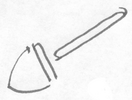
cna (canpa) = shovel
canpa cna shovel x1 is a shovel/spade [bladed digging implement] for digging x2 ao 6 (cf. kakpa, guska, tutci)
--Ron_Hale-Evans?
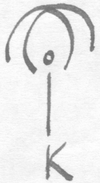
kik (ckiku) = key
ckiku kik key x1 is a key fitting/releasing/opening/unlocking lock x2, and having relevant properties x3 ao 20 [also x2 fastener, mechanism; code key (= termifckiku, kiktermifra); x3 is dependent on the type of key, but are those form properties of the key that enable it to serve the function of opening the lock - in the case of a metal key to a padlock, for example, this would be the shaft and teeth]; (cf. stela)
--Marty_Hale-Evans?
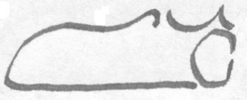
cuc (cutci) = shoe
cutci cuc shoe x1 is a shoe/boot/sandal for covering/protecting [feet/hooves] x2, and of material x3 3f 28 [also boot (= tupcutci)]; (cf. smoka, taxfu, skiji)
--Ron_Hale-Evans? and Marty_Hale-Evans?
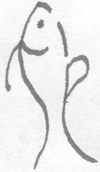
fip (finpe) = fish
finpe fip fi'e fish 'fin' x1 is a fish of species x2 [metaphorical extension to sharks, non-fish aquatic vertebrates] 5b 46 (cf. danlu)
--Marty_Hale-Evans?
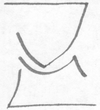
jul (junla) = clock/timer
junla jul clock x1 is clock/watch/timer measuring time units x2 to precision x3 with timing mechanism/method x4 3e 5 [also timepiece]; (cf. cacra, mentu, snidu, tcika, temci)
--Ron_Hale-Evans?

kal (kanla) = eye
kanla kal eye 'ocular' x1 is a/the eye [body-part] of x2; [metaphor: sensory apparatus]; (adjective:) x1 is ocular 1c 0 [x1 is optic]; (cf. jvinu, kerlo, viska, kumte)
--Ron_Hale-Evans?
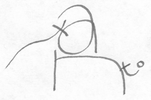
xanto = elephant
xanto elephant x1 is an elephant of species/breed x2 ai 16 (cf. mabru, barda)
--Ron_Hale-Evans?
For a similar (and entertaining) project in English, see Bembo's Zoo. (Requires Macromedia Flash.)